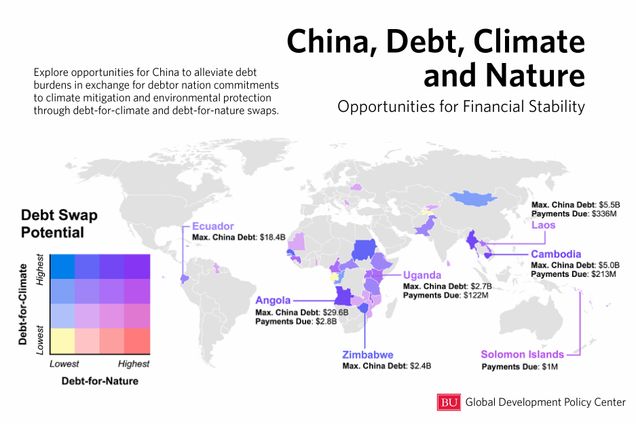China Can Help Solve the Debt and Environmental Crises
In a new journal article published in Science, research by Blake Alexander Simmons, Rebecca Ray, Hongbo Yang and Kevin P. Gallagher explores opportunities for China to alleviate debt burdens in exchange for debtor nation commitments to climate change mitigation and/or adaptation and environmental protection through “debt-for-climate” and “debt-for-nature” swaps.
Many developing countries are experiencing mounting external debt distress owing to the economic consequences of COVID-19. G20 Finance Ministers were swift to adopt the Debt Service Suspension Initiative (DSSI) in 2020, suspending bilateral debt payments for 73 low-income countries through July 2021. For the 46 participating DSSI countries thus far, payments due to China constitute 68 percent ($8.4 billion) of all official bilateral payments originally due by the end of 2020. G20 countries have now come to realize that they will need to go beyond debt suspension to include the cancellation of some portion of debt. Without substantial debt relief, developing countries will face pressure to exploit natural capital to pay short-term debt, placing conservation and climate change ambitions aside.
It is therefore of paramount importance to align debt restructuring efforts with climate, biodiversity, and development goals. Although China has only recently become a major creditor, it has already built a strong record of bilateral debt relief and has begun to advocate for linking biodiversity, climate change, and international finance.
This article identifies the countries that would benefit from participating in debt-for-climate or debt-for-nature swaps with China— including Angola, Cambodia, Laos, Myanmar, Senegal, Sudan, Zimbabwe, Fiji, Togo, Pakistan, Cameroon, Ethiopia and the Solomon Islands, based on their exposure to significant levels of Chinese debt and threats to their climate and biodiversity. The authors also explain why participating in such swaps would benefit China and cement its status as a global leader on climate.
Read the Journal Article Explore the Interactive Read the Blog